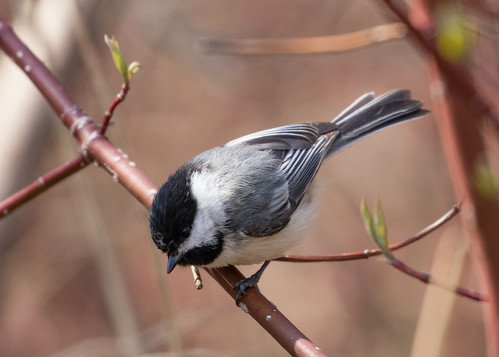Russ and I were walking along Peabody Street—our own
personal Camelot—at lunchtime on May 4 when we came upon two chickadees in a
singing tournament, one on either side of the road. The trees on that stretch
of the block include several very old ones. One big old birch looked exactly
rotten enough for a pair of chickadees to excavate a perfect nest cavity.
I’m
presuming that the bird on our side of the road was a male defending a nest in
that tree—he may already have a mate incubating eggs, or there may have been a
female flitting about nearby, ready to bat her nictitating membranes at
whichever male won the singing contest. A female chickadee, like Guinevere, is
very loyal to her Arthur, and will stick with him through thick and thin as
long as he doesn’t mind her occasional dalliances with the neighborhood
Lancelot.
Chickadees don’t live and die by chivalry codes or fight wars, so the
occasional extramarital fling doesn’t have any historical repercussions. What
ornithologists coyly call “extra-pair paternity,” wherein some of a female’s
young in a single brood of chicks have a different father than the others,
doesn’t lead to any practical repercussions for any of the chicks or adults
involved. So there aren’t any Mordred chickadees out there trying to wreak
revenge on a whole kingdom. Hanky-panky is the order of the day in the lusty
month of May.
On that same walk, Russ and I heard our friendly
neighborhood male Pileated Woodpecker drumming—he and the female show up a few
times a day in my yard, but I’m still trying to figure out where they’re
nesting.
Chipping and White-throated Sparrows have been singing away—they’re
just arriving, and haven’t started nesting yet. Crows are nesting in the yard
behind mine, but I haven’t found precisely where the nest is yet. There are
three pairs of robins on my end of the block again. One pair spends a lot of
time in my front yard, and another around my neighbor’s back yard. The
rainstorm on Friday produced at least a bit of a mud supply for them to start building
nests, so they should get going any day.
Robins usually choose either a conifer or a structure on a building for their first nest. One pair successfully nested under an overhang on my neighbors’ shed last summer, and I saw a male checking out that spot last week, so I’m keeping my eyes on it.
Robins usually choose either a conifer or a structure on a building for their first nest. One pair successfully nested under an overhang on my neighbors’ shed last summer, and I saw a male checking out that spot last week, so I’m keeping my eyes on it.
I’m still watching for my first backyard hummingbird—I saw
one briefly in the Douglas County Wildlife Management Area at the Sharp-tailed
Grouse observation blind last week, so I set out my feeders the moment I got
home. I also set out oranges—Baltimore Orioles often return the same day as the
hummers.
We haven’t had any of the weather systems that knock migrants down and
hold them here in inappropriate habitat for days at a time so far this spring,
so I’m mainly seeing the new arrivals that will be sticking around in my yard
rather than a variety of sparrows and warblers, but I keep myself planted close
to my window feeders just in case. Anything is possible in the lusty month of
May. In short, there’s simply not a more congenial spot for happily everaftering
than here on Peabody Street.


